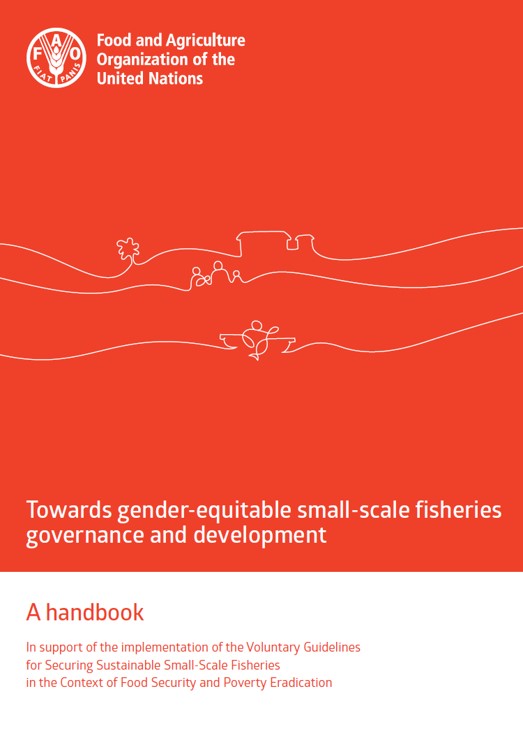A very welcome addition to the technical support for the implementation of the Voluntary Guidelines for Securing Sustainable Small-Scale Fisheries in the Context of Food Security and Poverty Eradication – a handbook – has just been released by the Food and Agriculture Organization of the United Nations (FAO). Called “Towards gender-equitable small-scale fisheries governance and development“, the handbook written by Nilanjana Biswas, of the International Collective in Support of Fishworkers (ICSF), is a treasure trove of essential background knowledge on women, gender and small-scale fisheries, combined with practical advice and case examples on incorporating gender equality principles in small scale fisheries work. The target audience is broad – from government officers to fishers and their comm unities, fish worker groups and researchers, as befits a product of the very participatory development process the Handbook team took.
unities, fish worker groups and researchers, as befits a product of the very participatory development process the Handbook team took.
The Handbook is organised in 3 parts:
- Part 1: Understanding gender and the role of women in small-scale fisheries
- Part 2: Responsible fisheries and sustainable development through a gender lens
- Part 3: Ensuring an enabling environment for gender equality and supporting implementation
Among the rich and varied advice and explanatory boxes are such gems as a guide to tried and tested FAO methods for assessing post-harvest losses, and disaster response and rehabilitation issues to target to help women. Throughout, the Handbook has action points for policy-makers and for community service organisations, offering a few key tips on each subject.
A particular highlight is the set of case studies, each containing a description of the case, followed by a gender-sensitive “Let’s analyse this…” section that gets to the heart of the gender issues.
Here is the list of Case Studies:
- Women in fishing communities on Lake Victoria
- Tenure rights of traditional fishing communities in Raigad, India
- Recognition of indigenous community-owned land in Nicaragua
- War-affected women in the fishing villages of the Mannar Coast,
Sri Lanka - Self-regulation by women harvesters in the Gulf of Mannar, India
- Mandira Marine Extractive Region, Sao Paulo, Brazil
- Transboundary issues and fishers – learning from India and Sri Lanka
- Transboundary issues and fishers – learning from the European Union
- Diversifying livelihoods for small-scale fishing communities in Uganda
- Pacific Fishing Company on Levuka Island, Fiji
- Migrant Chinese women workers employed in oyster shucking in Japan
- Growing violence and abuse in small-scale fisheries in South Africa
- Reclaiming the Marol fish market in Mumbai, India
- Impact of harbour fishing on fish trade in Kerala, India
- Impact of competition along Lake Victoria in Kenya and on inland
fisheries in Zambia - Impact of industrialization on women in small-scale post-harvest
fisheries in South Africa - Issues of cross-border trade for traditional women fish vendors in
Cambodia - The risks of neglecting women in policy implementation
- Post-tsunami rehabilitation in Aceh, Indonesia
- Impact of mine pollution in Buyat Bay, Indonesia
- Matsyafed in Kerala, India – an apex cooperative for small-scale fisheries
- Impact of seasonal fishing ban on women fish traders in
Puducherry, India - Marshall Point, a coastal indigenous fishing/farming community in
Nicaragua - Women fishers fight corruption in the Sunderbans, India
- An example of value chain analysis (VCA) (in Malawi)
- Public hearing on issues of women in the fish trade in Kerala, India
- Enabling women’s participation in meetings in Kigombe, the United
Republic of Tanzania - Fisherwomen in Brazil organize for their rights
- Regional Fisheries Livelihood Programme for South and Southeast
Asia (RFLP) - Mainstreaming gender in the BOBLME project
